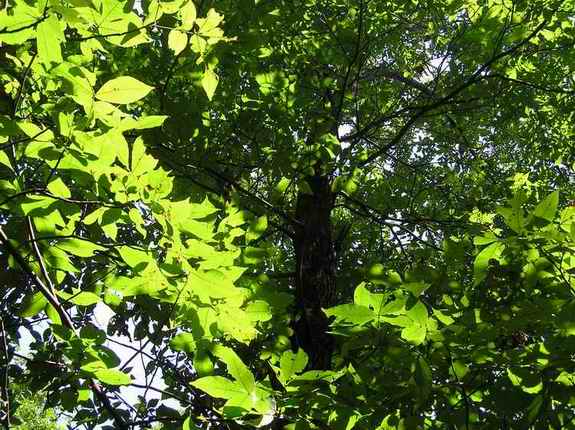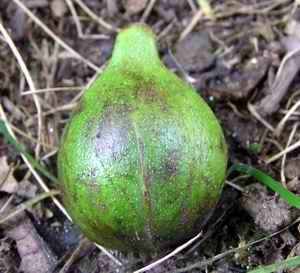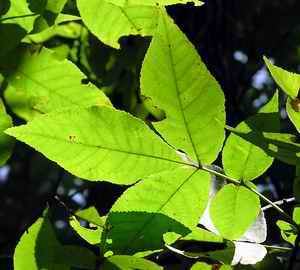|
Return to Hiker's Notebook Home Page
Common Name: Pignut Hickory, Broom hickory, Sweet pignut, Coast pignut hickory, Red hickory, Redheart hickory, Smoothbark hickory, Swamp hickory, Butternut hickory, Brown, Black and White hickory - The word "hickory" is from a 17th Century Virginia intermediate word pohickery which, according to Captain John Smith of Jamestown, is from the Algonquin Indian word pawcohiccora, a drink that the Native Americans made from the crushed kernels of the oily nutmeat. This particular species of hickory was christened "pignut" by early colonists to account for the fact that the young nuts of the tree were consumed by hogs.
Scientific Name: Carya glabra - The genus name is from the Greek word for walnut tree (Hickory is a member of the walnut family). The species name is from the Latin glaber which means smooth or bald; glabrous is a botanical term that means without hair or down. The leaves, twigs and buds of the species are characterized as glabrous. Also occasionally recorded as Juglans (the genus of walnuts) glabra and Carya porcina, which is from the Latin word for hog.
Hickory trees are one of the characteristic trees of the broad eastern upland climax forest formerly known as Oak-Chestnut and now called Oak-hickory. A climax forest is the ecological end point of a particular environment in which a self-perpetuating community of flora and fauna is in equilibrium. The transition from chestnut to hickory was observed to occur over a period of some 50 years; the original American chestnut succumbed to the chestnut blight (Cryphonectaria parasitica) that started in New York City in 1904. The Pignut hickory is the most dominant of the various hickory species in this association, as it is relatively shade tolerant and can thus propagate under the shaded canopy of the mature climax forest. Its profligacy can also be attributed to the fact that it is monoecious, having both male and female reproductive organs on the same tree. It has an importance value of 41 out of a maximum of 300; the red oak is 36 by comparison.
The fruit of the hickory is the characteristic nut, which, in the case of the
pignut, is more or less pear-shaped with thin husk that breaks away along four
sutures when the nut becomes dry. The Pignut hickory is a prolific seed
producer when masting
Pignut hickory nut kernels have very high levels of crude fat, up to 80 percent in some cases; they are accordingly an important part of the diet for wildlife. It is estimated that hickory nuts comprise between 10 and 25 percent of the overall diet of several species of squirrel and 5 to 10 percent of the diet of chipmunks. Wild turkeys eat the nuts and the flowers; black bears, rabbits and raccoons eat the nuts and bark; white-tailed deer browse on the leaves and twigs. The consumption of Pignut hickory nuts by humans is governed to an extent to the environment in which the trees grow, as some nuts are relatively sweet and pleasant; most are bitter and astringent. Native Americans used the nut of the Pignut hickory after the bitter compounds were leached out to make a paste for meal or flour.
The Pignut hickory is most celebrated for its extraordinarily tough wood to the extent that hickory is a metaphor for firm and hard, perhaps the genesis of Andrew Jackson's sobriquet "Old Hickory." Native Americans used lathes of Pignut hickory wood to make bows and, in the more northern regions, to tie together with thongs for snowshoes. The early settlers from northern Europe used hickory boards to make skis. These specialized applications for Pignut hickory wood attest to its high flexure to allow for the absorption of vibration. This characteristic also made it ideally suited for the manufacture of components for textile looms and for wagon wheels. The alternative common name "broom hickory" is reflective of the manufacture of brooms and brushes from Pignut hickory saplings. A knife was used to strip back the wood in strips that were then tied together to form the bristles. In addition to the broom, tough and flexible hickory is the preferred wood for tool handles, ladder rungs, baseball bats and agricultural implements. The high heating value of hickory wood promotes its use as a fuel; hickory trees are planted for timber in Germany. . |


 about
every other year. Even though only about half of the seeds are fertile, the
fertile seeds have a high probability (up to 75 percent) of hypogeal (below
surface) germination. The seeds are disseminated by gravity; dispersion
assistance is provided primarily by small ground mammals. Pignut hickory
leaves are pinnate with (usually) 5 leaflets.
about
every other year. Even though only about half of the seeds are fertile, the
fertile seeds have a high probability (up to 75 percent) of hypogeal (below
surface) germination. The seeds are disseminated by gravity; dispersion
assistance is provided primarily by small ground mammals. Pignut hickory
leaves are pinnate with (usually) 5 leaflets.